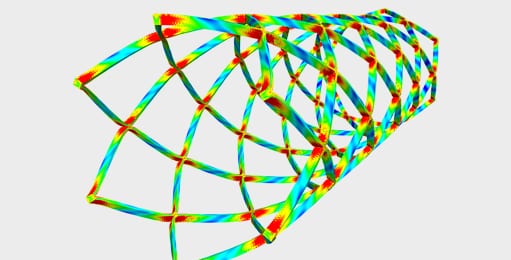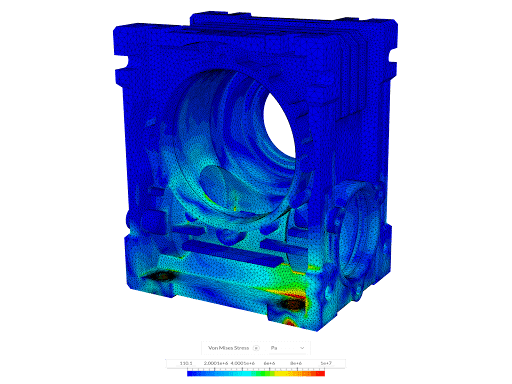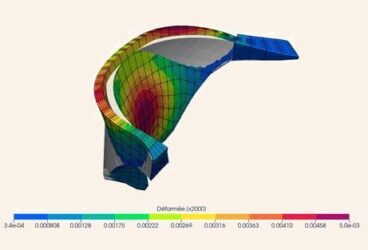The numerical simulation of structural mechanics brings enormous value to companies developing or manufacturing structures, machines, and devices. Simulating designs at an early stage can reduce costly and time-consuming physical prototyping processes, resulting in significant savings. In many cases, measurements for design verification are either impossible to make or very expensive and can add strong perturbation to the variable in question, leading to skewed results. Some products operate in environments and under conditions that are impossible and/or extremely difficult and expensive to recreate for testing purposes but can be modeled inside simulation tools at less cost and risk. For example, medical applications that require extensive and invasive human testing such as the nonlinear stress analysis of cardiovascular stents can now be easily simulated.
As FEA can be computationally expensive and time-consuming, leveraging the practically unlimited power offered by the cloud grants organizations speed, scale, and accuracy. With a web browser-based user interface easily accessed from anywhere, at any time, engineering teams of all sizes can start adopting engineering simulation earlier in their design and development processes and do more with simulation.
Structural simulation with a cloud-native solution means that, in one platform and using the same model, engineers can use different structural analysis types to holistically simulate and analyze their projects. Structural, thermal, and thermomechanical behavior can be investigated in order to find critical stress regions and unpredictable deformations stemming from the complexity of real-life scenarios.
Structural Analysis and Simulation
Simulations of structures, including linear static and nonlinear quasi-static analyses, enable engineers to assess the structural integrity of a design, predict deformations and stress distributions. With a multiphysics simulation platform, users can simulate plastic behavior in nonlinear analyses but also include thermomechanical behavior in the analyses. Additionally, all types of nonlinearities can also be taken into account, including geometric, contact problems, and material. Applications include heavy machinery, industrial equipment, automotive and aircraft components, pipes, and bridge design.
SimScale is deployed as a SaaS engineering simulation platform offering a single user interface that supports the following analyses:
- Static – Linear and nonlinear analysis of displacements, stresses, and strains in one or multiple solid bodies
- Aluminum pipe bending (large deformations)
- Snap fit permanent deformation (plasticity)
- Rubber seal installation (hyperelasticity)
- Shaft and rotor interference fit (nonlinear frictional contacts)
- Dynamic – Transient calculation of displacements as well as stresses and strains in one or multiple solid bodies
- Shock
- Drop test
- Harmonic – Simulation of the steady-state structural response of solids applied to periodical (sinusoidal) loads
- Shaker table testing – sine swept
- PCB vibration
- Bracket and fixation assessment
- Frequency Analysis – Calculation of natural frequencies of oscillation of a structure and the corresponding oscillation mode shapes
- Modal surveying
- Prestressed eigenmode analysis (bolt prestress)
- Support and fixtures due diligence
- Heat Transfer – Calculation of the temperature distribution and heat flux in solids under conduction, convection and radiation)
- Transient power cycling
- Thermal packaging
- Thermomechanical – Calculation of the structural and thermal behavior of one or multiple bodies
- Thermal shock
- Thermal interference fitting
- Thermomechanical fatigue
Cloud-Native Engineering Simulation
As a cloud-native engineering simulation platform, SimScale facilitates a high degree of collaboration between team members and automates the most common steps of a simulation workflow, from CAD import and meshing to results analysis. The platform is based on a special meshing technique that ensures the mesh interfaces are both conformal between all parts and robust enough to apply to many types of CAD models the first time around.
Engineers can harness advanced solvers that account for thermal and structural behavior for fast and accurate assessment of deformation, stresses, and other design critical output quantities. Thanks to the huge computational power offered by the cloud, the accuracy of the simulations can be increased by performing more detailed analyses.
And, engineers can quickly investigate design changes with an intuitive post-processor, for a better understanding of mechanical, thermal, and thermomechanical phenomena. Physical variables including displacements, strain and stress types, reaction forces and moments, or even heat flux can be calculated and visualized. Further quantities including the force history of entire components, stress and temperature distributions, deformation, and much more can be post-processed within SimScale.
Structural Mechanics and Engineering Simulation in the Cloud
With SimScale, engineers can solve structural and thermal problems of industrial components, valves, medical devices, turbomachinery, pressure vessels, and much more. Engineers can benefit from a vast number of existing public projects, spanning multiple industries and applications, to serve as a starting point for their own studies. SimScale makes engineering simulation economically and technically accessible through an easy-to-use, browser-based solution that can be accessed from anywhere, at any time. This means, the scale of simulation projects can range from the analysis of coronary stents all the way to silo superstructures using solid elements without engineers having to worry about disk space, calculation, or post-processing speed.
Learn more in our whitepaper: Structural Mechanics Simulation in the Cloud





